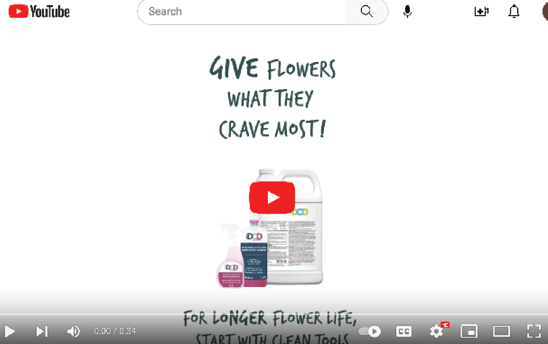The Professional Florist’s Manual for the Care and Handling of Fresh-Cut Flowers and Foliage
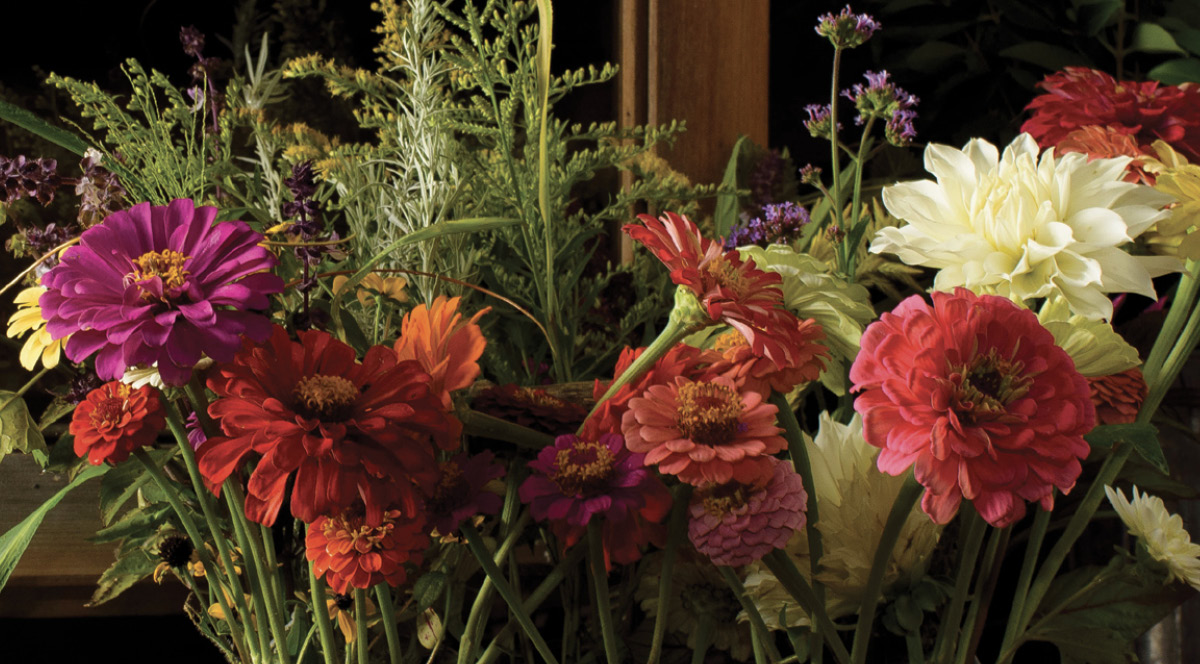
Objective of this Publication
The objective of this publication is to provide science-based information on the best practices and materials necessary to extend the display life of fresh-cut flowers. Anyone with an interest in maintaining the highest standards for fresh-cut flowers and foliage can benefit from the material covered here. It is especially helpful for students and professional florists.
Mississippi State University Floristry
Through the MSU Department of Plant and Soil Sciences, the Floral Management concentration is available to students within the Horticulture degree. The four-year degree involves sourcing, purchasing, distributing, marketing, designing with, and selling floricultural products. The program is also offered as a minor area of study. Students enrolled in Floral Management receive an optimal balance of courses in design, horticultural sciences, and business management.
Career opportunities for graduates include retailing, wholesaling, special event designing, and display gardening.
The University Florist, a professional flower shop owned and operated by the Department of Plant and Soil Sciences on the MSU campus, provides students opportunities to hone their design, sales, and management skills working in a retail florist setting. Student employees procure and process flowers, create floral arrangements, and install designs for weddings and events.
MSU Extension offers a wide variety of floriculture/ornamental horticulture information in the form of publications, programs, newsletters, videos, and classes. Floral courses and certifications are offered for consumer and professional florist levels: the MSU Extension Professional Florist program for professionals and the Master Floral Designer program for consumers. These courses blend a variety of learning opportunities with both online and in-person classes.
Introduction
Care and Handling: A Chain of Life
With the globalization of the cut-flower industry, flowers are now grown, harvested, and shipped around the world for use in floral designs. The sequence of handlers involved in moving floral products from greenhouses and fields to retail florists and finally to customers creates the chain of life for flowers. Each link in the chain must do its part to ensure flowers maintain the highest quality from grower to customer.
Care and handling: all the procedures accomplished to make flowers and foliage last longer
These are the links in the chain of life for fresh cut flowers and foliage:
Grower – Harvests flowers and ships to wholesale distributors.
Shipper – Ships by air or truck to wholesalers.
Wholesaler – Receives flowers from growers; sells to retail florists.
Florist – Receives flowers from wholesalers and local growers; sells and delivers to consumers.
Customer – Receives or gives flowers.
Vase Life and Senescence
The time flowers remain alive once arranged in a floral design is often referred to as vase life. With proper care and handling throughout the chain of life, florists can guarantee that quality flowers are used in each floral design sold. Optimally, flowers should have a vase life of about seven days. This is not true of all flowers (daffodils and tulips, for example), nor most designs (bouquets, corsages, arrangements delivered to funeral homes), but is a general consumer expectation for arrangements delivered to homes, hospitals, and businesses.
Vase life: the amount of time flowers remain beautiful and useable
All flowers have a natural end point. Senescence is the final stage of a flower’s life. During this final stage, flowers dismantle and reclaim cellular components and move remaining nutrients around for storage and to promote further growth.
Senescence: the death of plant tissues
When a flower is not properly cared for at any point along the chain of life, it will prematurely senesce. There are many reasons a flower may die prematurely. Here are some of the main causes:
- Inability of stem to absorb water
- Lack of carbohydrates
- Excessive transpiration
- Bacterial growth and disease
- Ethylene gas
- Improper surroundings/conditions
You will learn more about these causes later in this publication.
Customer Satisfaction
Study and pursuit of flower longevity is accomplished for one reason: customer satisfaction. Consumers must find value in their floral purchases, and one of the chief aspects of value is found in long-lasting flowers and arrangements. Consumers understand that fresh flowers will fade, but most want their flowers to last about one week. This is not the only demand of consumers, though. They expect a fair price, timely delivery, wide selection, ease of buying, friendly and courteous staff, and excellent design.
Gaining new customers is difficult. People do not always think of buying flowers as a gift and may opt for other items that are easily bought and shipped. If a customer buys flowers and then becomes disappointed in their purchase because the flowers did not match their expectations, they are not likely to buy them from the same retailer. The disappointed customer may never regain interest in flowers, perceiving them as a poor value, a waste of money that did not convey the intended message.
Staff must understand and follow proper care and handling steps. This will lead to many satisfied customers. One of the best compliments a florist can earn from a customer is, “Your flowers lasted such a long time!”
Receiving
Preparing for Arrival
Knowing your transporters’ delivery days and times will allow you to prepare for shipments. Get in the habit of noting when your perishable materials arrive at your location. Observe the time express shippers make their deliveries. Wholesale florists often have regular delivery days, and their routes can be based on the number of shops placing orders within the delivery area. More delivery stops signal the potential for late delivery to your location; fewer stops mean your delivery may be earlier than expected.
Be sure that pretreatments and long-term flower food powders and/or concentrates are stocked. Buckets should be sanitized, dry, and ready for processing. If space permits, it is a good idea to have buckets pre-filled with flower food solution. Remember, cut flowers and foliage only need a few inches of prepared solution in each bucket.
When does the FedEx/UPS or other carrier arrive daily at your location?
What are the delivery days and times for your local wholesalers?
Holding Temperature
If it is not possible to process your floral shipment immediately upon receipt, keep the boxes and wrapped flowers at a cool temperature. An air-conditioned environment is better than a warm, outside location. It is also beneficial to store the boxes in the cut flower cooler rather than keep them at room temperature. Cut flower boxes can be kept this way for up to one day before processing, but only if necessary. Remember that dry-packed cut flowers are under water stress, so hydrate them as soon as possible. Place boxes of fresh flowers on the horizontal rather than on end in the cooler. Keeping them vertical can place force on tender stems, breaking many of them and rendering them useless.

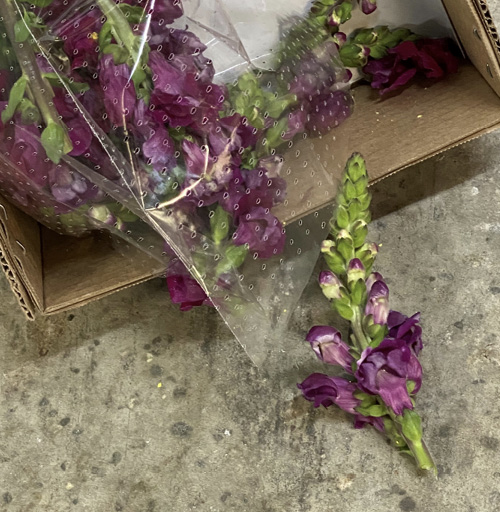
Security
Keeping incoming floral shipments secure is a top priority for retail florists. Never leave boxes and bundles of cut flowers unattended because they can be stolen or mistaken as trash and discarded. Cut flower shipments should be delivered to a secure location, away from foot and vehicle traffic.
Worker Safety and Protective Clothing
Avoid rushing around in any area in the florist shop, especially processing areas. Cutting tools, wet floors, and debris contribute to the potential for accidents.
Organize processing areas away from design benches, doorways, customer service areas, and other high-traffic areas. Ideally, a store should be designed to facilitate a workflow that includes delivery, processing, design, customer service, and display areas.
Keep work zones, especially the floors, clear of boxes and wrapped floral products. Workers can easily trip and fall in areas with multiple obstructions. Cut stems over a trash receptacle rather than directly onto the floor. Damp stems and leaves can cause falls.
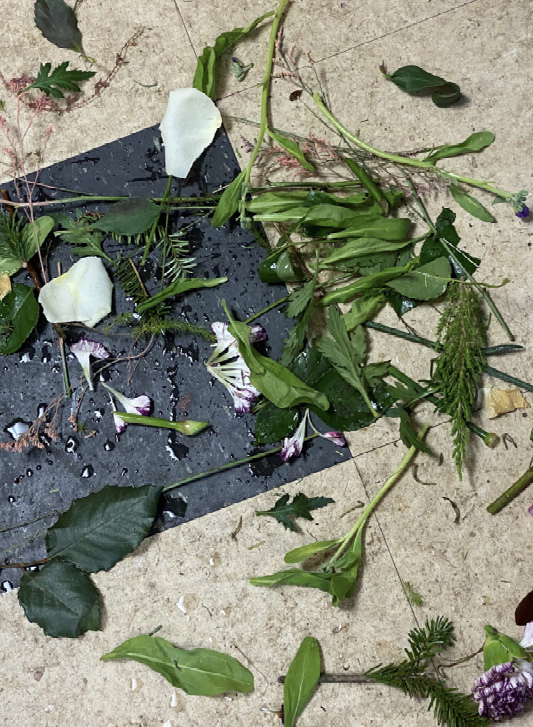
Processing areas should be well-equipped with storage for buckets, cleaning agents, post-harvest chemicals, trash bins, and composting receptacles. Keep the space clean and well-organized so that necessary products are within reach. Water spills as well as those from liquid chemicals are unavoidable. It is important to clean up spills as soon as possible to lessen the chances of employee injuries.

Processing flowers and cut foliage is one of the most important tasks, and the processing area is potentially the most important area in the store. If perishable materials are not properly cared for upon arrival, they will not perform well in floral designs, leading to customer dissatisfaction. Repeat customers are vital to the success of a retail store. Word-of-mouth advertising works in both directions, but unhappy customers tend to discuss what went wrong with their flowers more than those who were satisfied. A store’s profitability depends on using the best practices for floral care and handling.

Employees with the distinction of floral processors should be dressed for success at their work. They should wear closed-toe shoes with sturdy treads. Long hair should be held away from the face and hands. Long pants made from durable fabric will stand the tests of floral processing much better than dressy fabric. Remember, floriculture involves chlorophyll, water, and soil. A clean, neat appearance helps you to do your best work and makes a good impression on customers.
Aprons are made from a variety of materials including canvas and denim. They can reinforce the shop’s theme with their colors or logos. More frequent processing and sanitizing requires more equipment. Wholesale florists often wear waterproof boots and long lab coats. Rubber gloves protect hands from frequent contact with cleaners and other chemicals. Often, employers provide protective clothing items for flower shop workers.
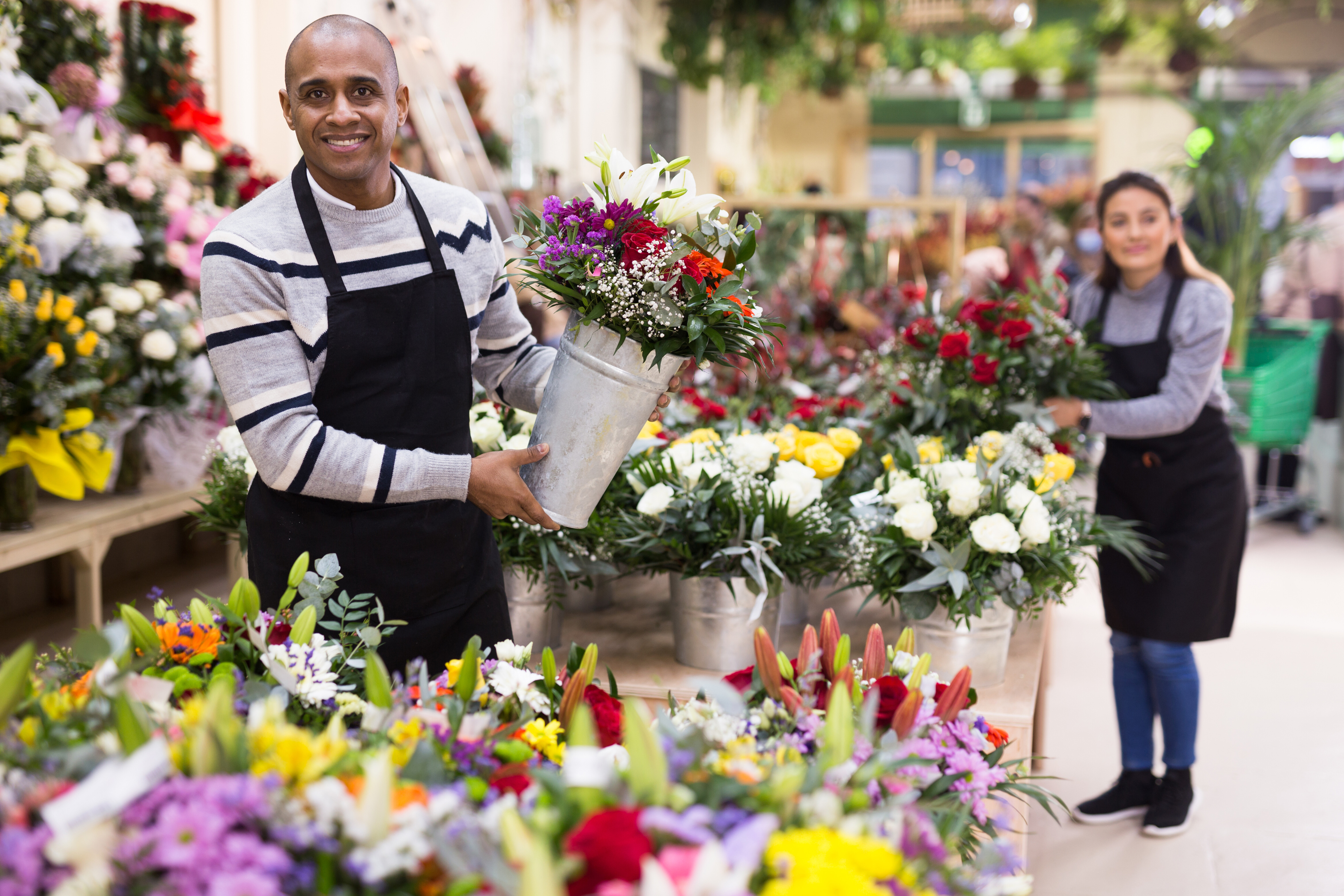
Safe Use and Care of Tools
Every florist shop task has a set of associated tools. Using the wrong tool or using a tool inappropriately can injure people and plant materials. Know the difference between each type of tool used in retail floristry.
|
Task |
Tool |
|
Cutting flowers |
cut flower knife, floral snips, stem cutter |
|
Cutting woody stem materials |
pruners, stem cutter |
|
Cutting wire |
wire cutters, multipurpose floral shears |
|
Cutting ribbon |
ribbon shears |
|
Cutting boxes |
box cutter |
Get in the habit of using the correct tool for the task. The processing area of a retail floral shop runs more efficiently with the proper supply of tools. Develop the good habit of placing tools in a dedicated spot rather than leaving them in different locations. This practice speeds up processing work and keeps employees from wasting time hunting for missing tools.
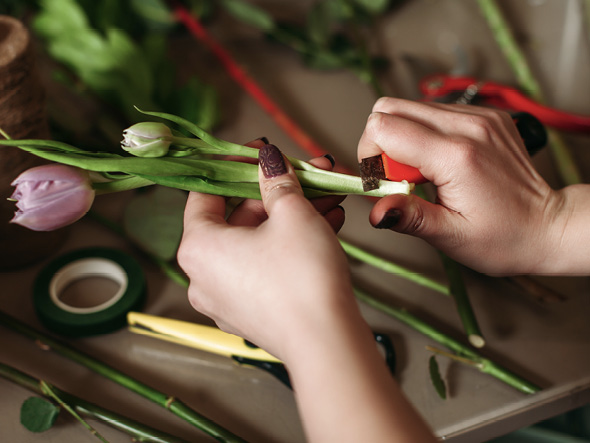
About once per month, make a point of oiling tools. Do not wash tools using soap and water to sanitize them because this will rust the metal. A sanitizing wipe works well. Another option is to wipe tools with a cloth dipped into a 10% bleach solution or bucket sanitizer solution. Be sure to wear rubber or nitrile gloves to protect your skin from strong sanitizers. Dry excess solution from the tools with a clean cloth, then add fine oil (such as WD-40) to tools with multiple parts such as scissors and pruners. Allow the oil to permeate the tool’s joints to prevent interior rusting.

Always avoid using tools for the wrong purpose. For example, do not use scissors to cut a box open. Flower knives will quickly become dull when used to cut cardboard. If limited to cutting soft, herbaceous stems only, a floral knife will keep its sharpness for a long time.

Remember that flowers are fragile, and every bloom has monetary value. As flowers are unwrapped or unboxed, take care to avoid breaking any stems or flower heads. Take care that cutting tools (knives, scissors, box cutters) do not cut into plant material within wrappings, whether wrapping paper, plastic sleeves, or newspaper.
Purchasing
The Flower Buyer’s Job
Purchasing cut flowers and greenery for a retail operation is an important job. The buyer or buyers must always strive to purchase the highest quality products at the lowest prices. Of course, this is the same goal of every flower buyer, which leads to competition in the overall marketplace. The greater the demand for flowers, the higher the prices. Prices increase during holidays and when wedding and prom flowers are in high demand. Red roses are in high demand and sold at high costs in the weeks leading up to and just after Valentine’s Day.
Orange and gold flowers are in higher demand around Thanksgiving than the rest of the year. You can expect to pay more for red carnations in December and around Valentine’s Day than other months of the year.

It takes time and effort to become an effective flower buyer. In new or small retail operations, the flower buyer may purchase floral materials from a few wholesale florists located with a few hours’ drive of the store. As the business progresses, buying may reach beyond traditional wholesale florists to brokers and farms. Finding various sources of high-quality floral products is an important job of the buyer; it takes much time and effort to do so. Indeed, sourcing is a significant cost for successful floral businesses. Selling the freshest, most unusual flowers is a value-added service for retail shops that most consumers demand. It is always best to buy from reputable sources. Once a new source has been discovered, give them a few trial orders before you depend on them for important holidays or wedding flowers.
Buyers must think about budgets and avoid rushing into purchases. It is easy to get caught up in the beauty of flowers or overbuy when there is a good deal. Flower purchases are usually made via credit cards, but some suppliers accept cash or checks. Some wholesalers allow retailers to purchase flowers and supplies on credit, and then pay the balance monthly, but this practice is considered outdated in most markets.
Determining the quantity of flowers to purchase is an important skill to develop. If you purchase too many flowers, shrinkage (flower loss) increases. To avoid this pitfall, buyers must anticipate their floral needs based on records. For example, how many red roses were sold at Valentine’s Day in the previous year? How many cases of evergreens were used during the last Christmas holiday season? Were any of these materials disposed of because they remained unsold?
It is also recommended that buyers interact with other buyers they can trust, to exchange sourcing information. Membership in state, regional, national, and international florist associations can connect you to likeminded, savvy businesspeople who have a wealth of buying source information.
Bulk Floral Sources
No matter where you get your flowers, buyers should build good business relationships with their suppliers. This allows the supplier to gain better insight into your store’s needs. If they know more about your store and your clients’ desires, they will be better equipped to meet your needs.
Wholesale Florists
A wholesale florist is often the most convenient and comprehensive source for cut flowers, cut ornamental foliage, and florist supplies. Wholesalers buy from many sources, including flower farms throughout the world. Flowers and supplies from the wholesale florist may cost more than buying directly from the farm, or they may be the same. They may also have cheaper prices! Because of this variability, it is important to monitor prices of individual crops over time.
As buyers become more experienced, they learn the best sources for the flowers their shop stocks.
A buyer may purchase greenery and supplies from one wholesaler, seasonal cut flowers from another on the other side of town, and roses directly from a grower. It is always good practice to buy from a variety of suppliers and avoid “putting all your eggs in one basket.” A wholesale florist makes purchasing flowers and supplies easy because they have already sourced a wide array of products and keep them on hand. Because their inventories are diverse, from seasonal cut flowers to daily standards, they become a one-stop shop, saving the retailer time and effort. Many wholesale florists deliver their products directly to retailers for a fee, which is an additional benefit. Delivery dates and times vary according to distance and preset schedules.
Brokers
A broker is an entity between farms and retailers. They do not have a brick and mortal store like a wholesale florist but rather connect their retailer clients to flowers from multiple farms. Brokers charge a fee for sourcing products. The retailer simply provides an order to the broker who, in turn, connects to a network of flower farms. Brokers coordinate delivery of the flowers directly to the retailer, and the retailer pays one concise bill. Brokers can sell unique flowers from distant or remote farms that are not easily found at local wholesalers.

Farms
Buying flowers directly from the farm guarantees freshness and typically costs less. There is no middle point as with the traditional wholesaler, where flowers may be stored dry or in water for days or weeks before being sold to retailers. Farms sell freshly harvested flowers and greenery and express-ship them directly to the retailer. On the other hand, farms may have a narrow variety of available flowers, and they may require buying in large quantities. Growing flowers is challenging, and not every farm grows multiple types of flowers due to growing conditions, climate, and know-how.
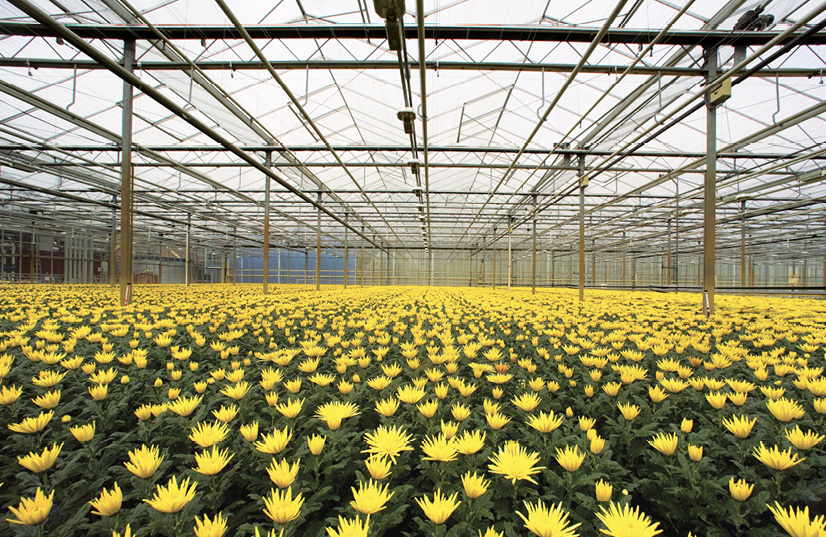
Large flower farms pack and ship their flowers in shipping boxes that are designed to withstand a moderate amount of handling. They often use air freight, shipping via refrigerated truck (Armellini and Prime are examples), shipping via carrier (FedEx, for example), or a combination of all transportation methods.
Sanitation
It bears repeating that sanitation practices are critical in floristry. The working environment must be as clean as possible to prevent the spread of pathogens. There are multiple disinfectants, cleaners, and sanitizing solutions available for florists to keep their workspaces, coolers, and overall shops clean.
Cleanliness helps keep flowers free of disease and looking their best for as long as possible, and it also communicates to your customers that you are a professional florist who cares for the establishment and the products you sell.
Tables and Tools
All worktables and tools should be cleaned and sanitized daily. Spray the tops of workspaces with a sanitizing spray and wipe with a clean cloth. At the end of each day, clean tools to ensure they work their best for the longest possible time.
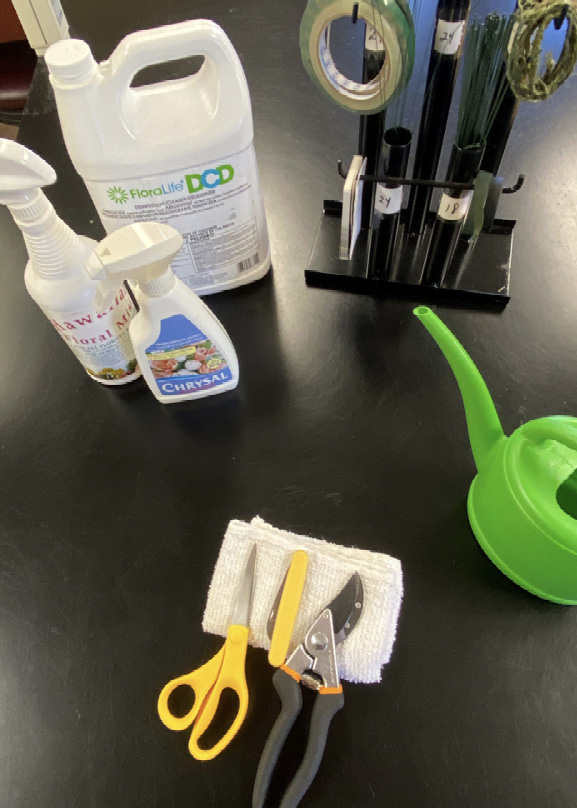
Floors
Sweep the floors in the work area, walk-in cooler, and salesroom of the shop daily to remove any stem clippings, petals, and leaves. Once weekly, mop the workroom floors with a sanitizing floor cleaner to prevent the spread of bacteria and disease that can be harmful to cut flowers.
Cooler Interior
Sweep the cooler shelves and floors daily to remove flower petals and leaves that may have fallen from stored flowers and foliage. Once a week, clean the cooler thoroughly using the following steps:
- Completely empty the cooler of boxes and buckets. Temporarily place them out of the way of foot traffic.
- Sweep the floor of all loose leaves and stems.
- Wipe down the shelves and walls with a sanitizing solution.
- Mop the floor of the cooler using a sanitizing floor cleaner.

Buckets
Buckets should always be clean and sanitized before placing fresh-cut flowers into them. Dirty buckets are breeding grounds for bacteria that can attack flowers, causing them to die in the cooler prematurely. Reusing a bucket without properly sanitizing it is like using a dirty bandage on a wound; it introduces pathogens to the cut ends of stems.
Wash all buckets with a disinfecting solution. Quaternary ammonium compounds (“quats”) are products made specifically for cleaning buckets that will be used to store fresh-cut flowers. These cleaners have a residual cleaning effect, staying sanitary long after washing and drying. Take care to use these cleaners only as directed, and avoid using them on utensils and plates.
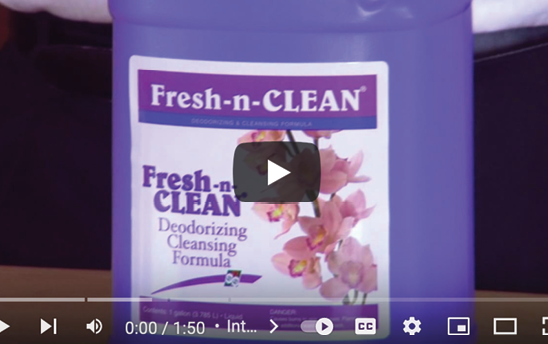
The drying phase of sanitizing buckets is important. Their surfaces must be dry before they are stacked; otherwise, pulling them apart is difficult. Develop a system for keeping track of dirty and clean buckets, and make sure all store employees are aware of the method. For example, buckets that are upright are dirty; buckets turned upside-down are clean.
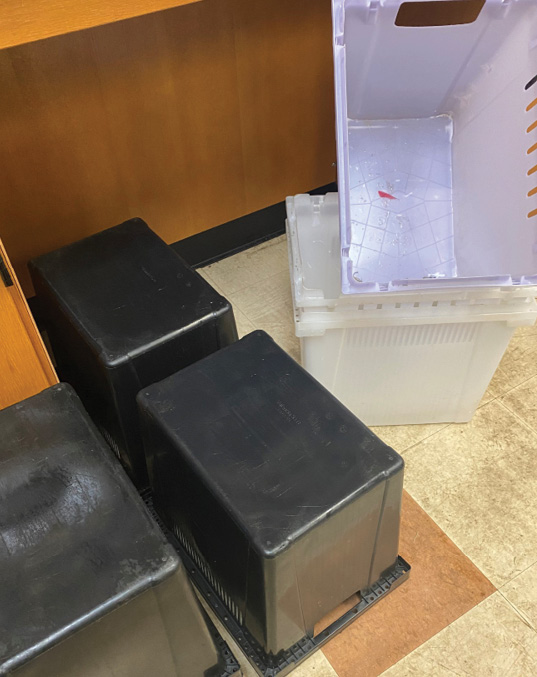
Scrub both the interior and exterior of buckets with a stiff-bristled brush or scouring pad while emersed in the water/cleaning solution mixture. Once scrubbed, rinse buckets with clean water and turn them upside-down to air dry. Once dry, buckets can be stacked together and stored.
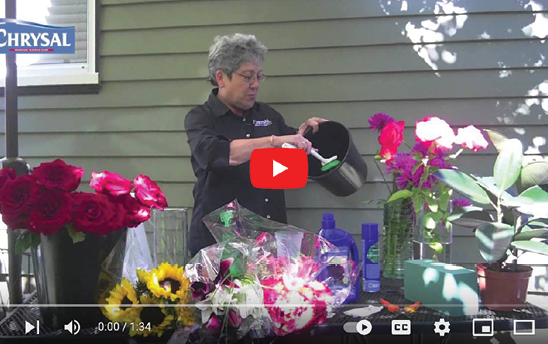
Sinks
Scrub and clean the interior walls of the sink daily or at least before buckets are washed.
Leaf and flower debris that can collect in buckets has a nasty habit of clogging sink drains when the buckets are emptied. To prevent this from happening, place a piece of mesh wire in the bottom of the sink to catch debris. The wire can be lifted out to easily dump debris collected in the bottom of the sink. You can purchase rolls of wire at most local hardware stores. It is also a good idea to keep a small plunger dedicated to sink clogs.
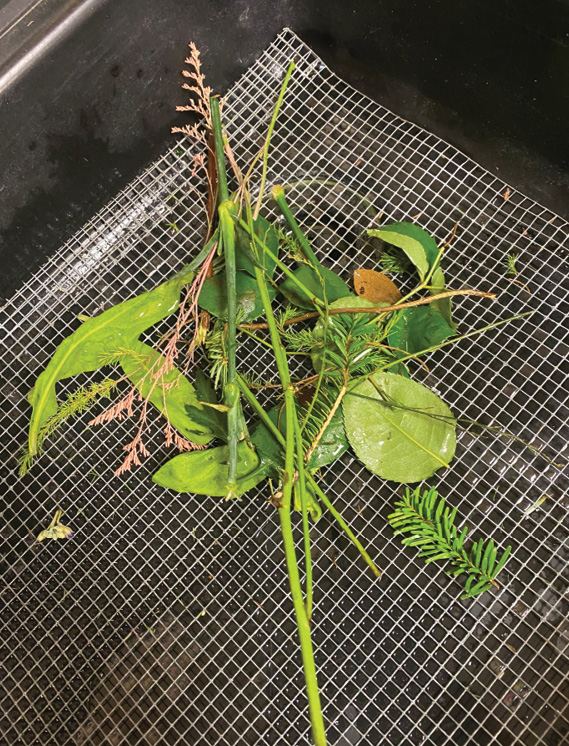
Garbage Bins
Empty garbage bins at the end of each day. Clean and sanitize the interior of garbage bins at least once a week.

Alternative Waste Disposal
In recent years, there has been an increasing consciousness within the floral industry toward sustainable practices. Flower growers, wholesalers, retailers, and consumers are more aware of the environmental impacts of growing, shipping, and retailing flowers.
Composting is one alternative waste management method to traditional landfill dumping. An added benefit is that compost is a valuable commodity for floriculture. If the shop cannot handle composting floral waste in-house, see if there are any organizations in your area that offer compost management, such as Master Gardener groups, universities, community garden groups, and city composting programs.
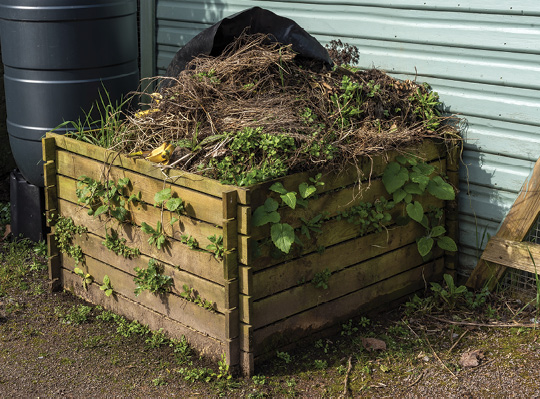
While composting floral waste is not feasible for every flower shop, it can be a way to attract environmentally conscious customers. Be sure to market your shop’s efforts to become more sustainable.
Sort and store floral waste intended for composting separately from non-compostable materials. Floral foam, plastics, wire, and some foods (such as dairy and meats) are not compostable. Store floral waste intended for composting in trash cans without trash bags. Clean and sanitize the trash cans after every use. Floral waste has been found to work in both mound composting (merely heaping the green material into a pile) and vermicomposting (using earthworms to create compost) systems.
Cleaners
Several cleaners are made specifically for retail floral settings. Post-harvest chemical manufacturers often supply different types of cleaners in the product lines. You can also use a mixture of bleach and water to clean and disinfect tools and surfaces. Use the following solution of bleach and water on these surfaces:
1 tablespoon of bleach per 1 quart of water
or
¼ cup of bleach per 1 gallon of water
Either of these ratios will give you a 500–800 ppm disinfecting solution. Make fresh solution daily.
Treatments
Once flowers and cut foliage are checked in, it is time to process them. Treatments can help ensure cut plant materials have a long vase life (the amount of time flowers remain beautiful and usable). Some plant materials respond well to pretreatment solutions to improve floral longevity. Be sure to read and follow label directions for all treatments.
Pretreatments
One type of pretreatment is a citric acid pulse. It is called a pulse because the treatment duration is quick—about the same amount of time as a heartbeat. Citric acid pretreatments hydrate flowers efficiently, so they are often called hydrating solutions. Acidified water tends to flow readily from the solution into the stem. Citric acid pulses also are low-pH and create an environment within plant cells that is detrimental to the proliferation of bacteria. Simply put, bacteria do not reproduce quickly in acidified water. Once a flower stem or a bunch of stems is cut, dip the fresh tissue into a very shallow amount of the solution for one second, then immediately place the stems in a long-term flower food solution.
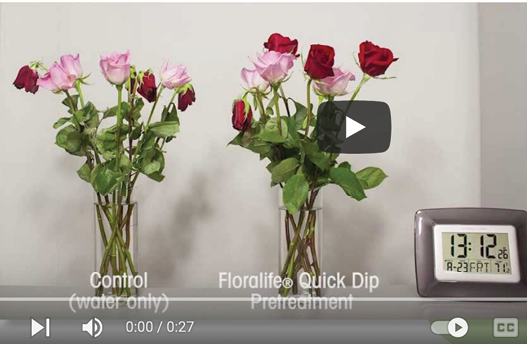
Another type of pretreatment has high concentrations of carbohydrates. Non-bulb-type flowers that are expected to bloom with unfurling petals benefit from the sugar boost these pretreatments provide.
Some hydrating solutions contain aluminum sulfate, like powdered alum. This chemical is known to aid water uptake. Many florists dip cut stems of hydrangea, a wilt-sensitive cut flower, into powdered alum.
Floral hydration is slower but more even in cool solutions.
Holding Solutions: Cut Flower Food
Fresh flower food solutions contain three main ingredients: carbohydrate, citric acid, and a biocide. Carbohydrate is a sugar that provides cut flowers with energy to aid in blooming. This component is good for non-bulb-type flowers with blooms that unfurl, like roses. Bulb flowers do not benefit from the added carbohydrate because they do not need additional sugar. Flowers such as gerbera are already in full bloom upon harvest, so they do not benefit from the carbohydrate addition. The carbohydrate in fresh flower food solutions does not harm these flowers; they just don’t use it.
Citric acid helps the flow of water into the stem and from cell to cell. In addition, bacteria does not grow quickly in water with a low pH level (acidic). However, after about three days, bacterial growth overcomes the acidic water environment for flowers stored at room temperature. This is why vase and bucket water should be changed every few days for flowers displayed at room temperature. Flowers stored in refrigeration can remain in fresh flower food solution for weeks because the low temperatures hinder bacterial growth.
The third component, a biocide, helps to keep bacterial growth in check. Remember that one of the chief problems associated with cut-flower longevity is bacterial blockage. Bacteria grows at the cut end of the stem where water is taken up into the stem, but manifests itself as wilting at the weaker stem neck and flower petals. Bent neck is a phenomenon where the part of the stem just underneath the flower head wilts. Some florists add wire bracing to their cut flowers to keep flower heads upright. However, this increases supply and labor expenses.
Flower food powder mixes more effectively in warm solutions because the heat dissolves the sugar.
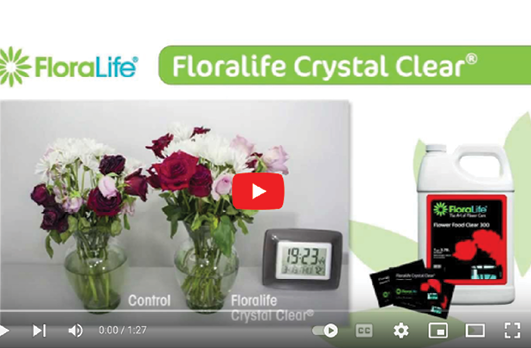
Recutting plant stems exposes fresh tissue to water uptake. Some fresh flower food solutions new to the marketplace do not require stems to be recut, which saves labor time when processing fresh flowers. Once flowers arrive from the wholesale source, simply remove any foliage below the water line and place in fresh flower solution.
Chlorine has been found to limit bacterial growth in bucket solutions. Flowers like gerbera have longer vase life when stored in this chemical. It is used mostly at the grower, rather than retail, level.
Once flowers have been pretreated and placed in flower food solution, keep them at room temperature for at least one hour before refrigeration. This period allows flowers to fully take up the flower food solution so that the leaves and growth terminals are fully turgid, which is the state where plant cells have taken up the maximum amount of water. A turgid plant cell is puffy, while a flaccid plant cell is misshapen and loose. Wilting is the manifestation of flaccid plant cells.
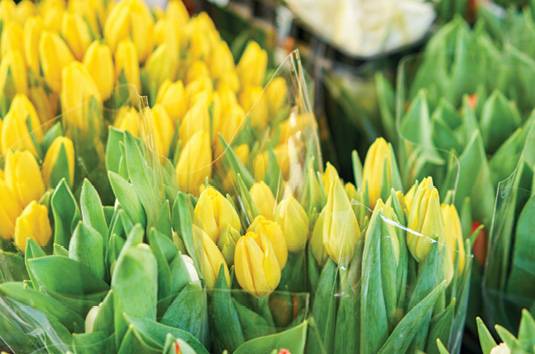
Post-Design Mists, Sprays, Dips
When a designer completes an arrangement, there are two categories of post-design treatments that can further increase the amount of time designs remain beautiful.
The first type of finishing treatment is an anti-transpirant. Transpiration is the movement of water across plant tissues into the open air. In floral designs that are not kept in water, it is important to keep existing water within the cells as much as possible. This is accomplished is by coating leaves and petals with a sealant solution. Anti-transpirants are applied as a liquid spray or dip that eventually dries and coats plant stomates, the natural openings found mostly on leaf undersides. You can think of anti-transpirants as a plastic coating for flowers and foliage.

Anti-transpirants slow down wilting of flowers to wear and carry, such as corsages and bridal bouquets. These floral designs do not have a water source, so it is important to seal them to slow wilting. The effect keeps them fresher looking for a brief period, depending on environmental conditions like ambient temperature and relative humidity. Still, adding an extra hour or two of fresh appearances can make a big difference in wedding or prom flowers.

A second type of post-design treatment is used for flowers and foliage displayed in water. These sprays contain plant hormones that promote cell elongation or growth. If plant material is growing, it takes up water, which results in a healthy, fresh appearance. While anti-transpirant sprays must coat all petal and leaf surfaces, hormone-containing sprays are applied as a light mist to vase and floral foam-based arrangements.
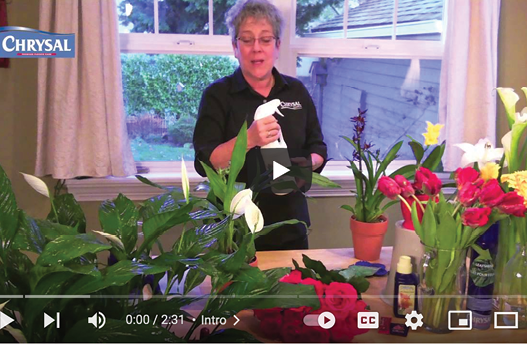
Using a hormonal spray on a corsage or an anti-transpirant on a vase arrangement does not harm the flowers, but knowing the difference between the two can help you match the right treatment to the task.
MCP: An Anti-Ethylene Compound
Ethylene is an odorless, colorless gas given off by aging plant materials, fruit, cigarette smoke, and other sources. Plant materials produce this gas as a way of moving from the flowering phase to the fruiting phase of their lives. As a part of this process, flowers drop their petals and flowers to create seeds within fruit. A compound (1-methylcyclopropene, known as 1-MCP) is used at the grower level to counteract ethylene synthesis. 1-MCP is released as a gas in greenhouses and large coolers and inhibits ethylene production.
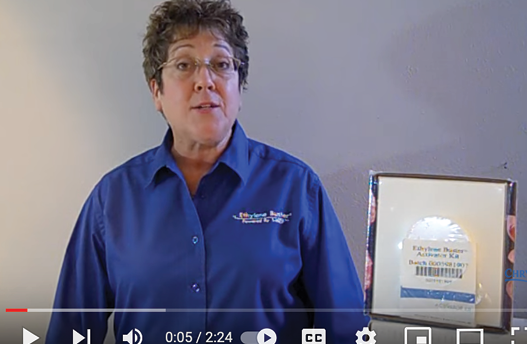
Processing
Proper processing of cut flowers is key to providing customers with the longest lasting floral products possible. Do not skip any of these steps! They are some of the most important processes in any floral business.
Note that there are a variety of treatments, explained in the previous section. Read all label directions and note which treatments are best for the varieties of flowers stocked in your store.
Before You Begin
You can anticipate flower processing and work ahead of schedule, saving time and effort, by preparing the processing area. Keep all buckets, cutters, and floral chemicals organized and clean. Before flowers are unpacked, or even before they arrive in the shop, prepare bucket solutions in sanitized holding containers. By doing this, the buckets will be ready to receive the cut flowers and begin the hydration process.

At this point, staff who are processing the flowers should monitor all incoming cut flowers. Did the shop receive the correct order? Does the delivery match the invoice? Are the materials fresh and high quality? Do the flowers show any signs of damage during transit?
If the materials were damaged by the carrier, bring the problems to the attention of management right away. Many wholesalers, brokers, and farms require digital images as proof of damage. If you wait too long to contact the seller, they are less likely to offer discounts, refunds, or replacement. Most times, your cut-flower order will arrive in tip-top shape.
Remove Packaging
Remove all packaging materials from the cut flowers. This includes paper and cardboard wraps used on roses. Take care to cut the flower sleeves rather than tearing or pulling them. Be sure to separate plastics from compostable materials.
Keeping wrappers in place does not help flowers stay fresher longer, but they can help prevent mechanical damage caused by things bumping into the flower heads, petals, or leaves. Sometimes, leaving the wrappers in place can be a good idea (for example, if they will be transported to another site soon after receipt in the shop).

Much of the packaging used with floral crops is meant to keep moisture in place during shipping. Now that the flowers will be placed in water, this packaging is not needed, and keeping it on the flowers can increase gray mold growth. Air circulation is vastly improved by removing the wrappings.
Gray mold is a fungal disease that blights flowers, leaves, and stems. Old and wounded tissue is susceptible. It is common in wet or very humid conditions.
Some florists keep wrappers on their cut roses with the idea that the binding keeps the flowers from opening. Some customers do not want open rose blossoms and feel that roses in bud are fresher and last longer. But constricting the flower does not halt time. Flowers from the same shipment that are kept wrapped are the same age as those that are unwrapped.
However, with cut tulip bunches, you might want to keep flowers in their shipping wrappers. Tulips will appear full of water and turgid upon arrival, but indeed they are water-stressed. Leave their plastic or paper sleeves in place during the hydration phase to provide support for the stems. Without support, the stems will become turgid while bent, which results in a wilted appearance even when very fresh. Customers will complain about the wilted tulips they received, and floral designers will be frustrated by these flowers that appear to hang over the containers’ sides.
It is important to know characteristics of different flowers and how the flowers will be used so you can make the right decisions when you receive them.
Cut Stems
Before placing flowers in any solution, be sure to remove any loose foliage or leaves that fall below the water line in the buckets. Do be sure to leave all healthy foliage on the stem above the water line. Every time a leaf or petal is removed from a cut flower, a small wound is made at the surface contact point. Such wounds provide sites for moisture loss and pathogen entry. Further, wounding causes ethylene synthesis. Reduce cut plant material wounding as much as possible.
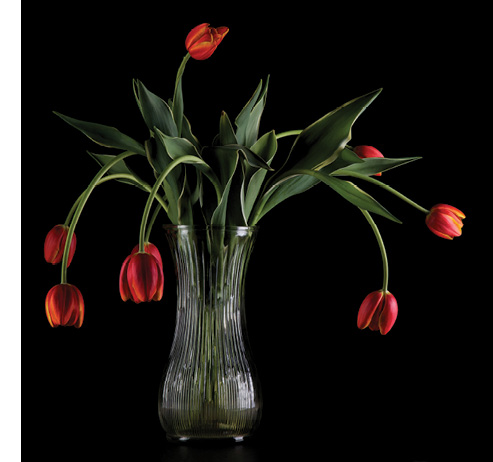
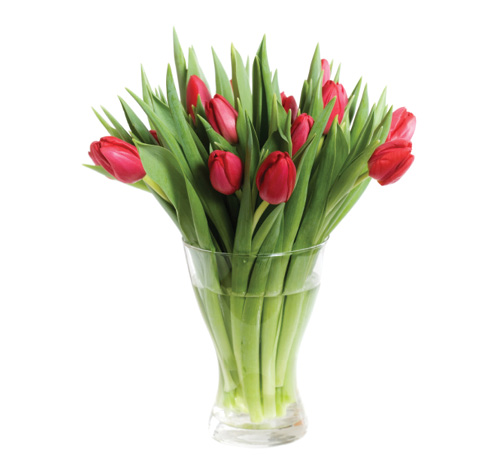
The next step is to cut all stems at a sharp angle to expose fresh tissue. The cut stems will readily take up the flower solution. Additionally, cutting flowers at a sharp angle keeps individual flower stems from sealing themselves to the bottom of buckets, which prevents the uptake of water.
When plant material is cut, the stems produce natural waxes that help it heal. The problem for floral design work is that the waxy scab becomes somewhat impervious to water. It must be removed. This is best accomplished with a sharp blade. You can use a flower knife or, if processing a larger number of stems, a bunch cutter. If you are cutting woody stems, use sharp pruning shears.
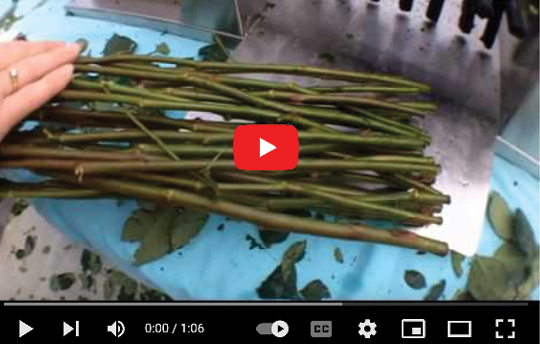
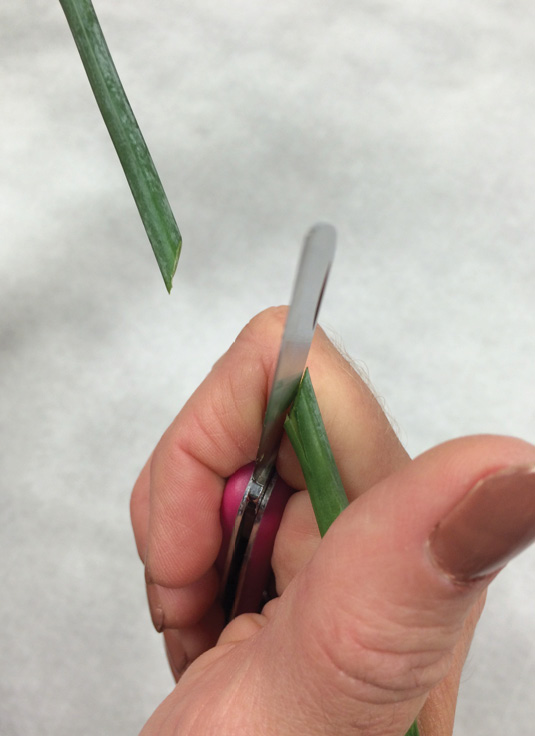
Professional florists who care about floral longevity use the right tools for the job. Avoid cutting flower stems with wire cutters or scissors; these pinch water-conducting vessels closed.
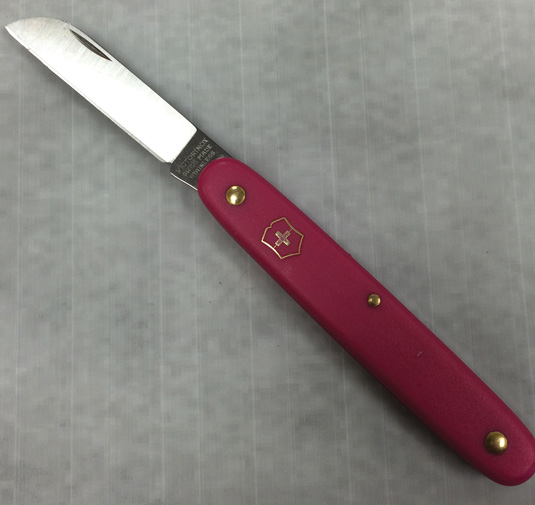
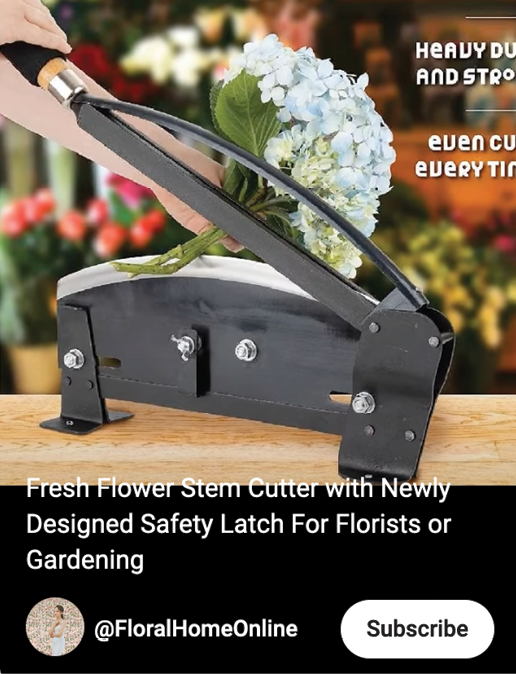
When judging where to recut the flower stem, weigh both freshness and value. You must cut away any of the stem with dried or otherwise damaged vascular tissue, yet leave as much of the stem intact as possible. Cutting more than necessary removes the valuable length of stems. All shop employees should be aware that the wholesale cost of roses is found not just in the flower head itself, but in the length of the stem. The longer the rose’s stem, the higher its wholesale cost. Observe the tissue at the base of the flower; often, it will be brown and in decline. You must cut above that point. Following are general guidelines for cutting distance.
|
Stem length |
Cut distance |
|
50 cm/20 in |
5 cm/2 in |
|
60 cm/24 in |
8 cm/3 in |
|
70 cm/28 in |
10 cm/4 in |
Shorter materials like tulips respond best with a cut of about 2.5 cm/1 inch. If there is any white tissue at the base of the stem, be sure to make the cut 2.5 cm/1 inch above it because it does not conduct water readily. This is a good guideline to keep in mind not only for tulips but also Dutch irises and gladiolus.
Note that some fresh flower foods do not require stems to be recut. These fresh flower food solutions are drawn into the stems, past the waxy scab that naturally forms at the cut point. Seek these products out from your floral supplier and use them to greatly lower labor time and expense.
Once stems are cut, place them immediately into the flower food solution. Do not cut stems and then leave them on the counter while accomplishing other tasks. This only causes scabbing to develop.
Leave the flowers in the solution for a minimum of one hour before refrigeration. This gives the flowers time to fully hydrate, allowing leaves to unfurl from the tight packaging and become turgid. They are now ready for floral design use or refrigerated storage.
Cut Greenery
Many types of cut foliage are packed and shipped in waxed cardboard boxes. Within the box, greenery is enveloped in plastic film to keep it hydrated. These cut greenery varieties are long-lasting on their own and do not need additional processing and hydration. Simply store the box in the cut flower cooler and keep it closed to avoid moisture loss. Design and sales staff must continue the habit of keeping these boxes closed after removing the foliage. Do take the time to prepare the box for safe storage and ease of product retrieval.
One method that helps designers gain quick access into the box is to cut the box lid on three of its four sides using a box cutter. Avoid using floral knives for this purpose because the cardboard dulls the blade. This cut creates a hamper lid. Carefully untuck the film surrounding all the foliage bunches, then retuck it lightly over the top bunches so that they are covered. Employees can retrieve foliage one bunch at a time by simply opening the lid, turning back the plastic film liner, removing a bunch, replacing the film over the remaining greenery, and closing the box’s lid. Take care when creating the lid to avoid damaging any of the box’s foliage contents.

Some retailers and wholesalers open foliage cases by pulling open the box flaps. This causes the heavy-duty staples to open, exposing their sharp edges. These open staples can cut and scratch employees’ hands and catch on and damage their clothing. If this box-opening method is used, be sure to use pliers or wire cutters to remove loosened box staples.
Storage
The Cut Flower Cooler
A floral cooler is a tool to keep cut flowers fresh for longer periods compared to storing them at room temperature. Considering the cost of flowers, a cooler is a good investment.
A floral cooler is a simple design involving a well-insulated box or room and a refrigeration unit. The refrigeration unit’s components include cooling coils filled with refrigerant chemicals, a fan, and a motor. The fan blows the cold air from around the coils into the air in the floral cooler, keeping the enclosed space cold.

Professional-grade floral coolers use low-velocity fans that blow the cold air from the cooling coils into the cooler. This helps the cooler keep the right humidity level without moisture accumulating. Surface moisture encourages fungal growth.
Beverage refrigerators and similar food-grade coolers should not be used to store cut flowers. They have high-velocity fans with fewer cooling coils than professional cut flower coolers. Cans and bottles do not require high humidity, just cold air, and these coolers cost less to produce because they have fewer coils. In addition, a beverage cooler’s high-velocity fan can dry out cut flower tissues quickly, even if they are in water.
Temperature
Most floral crops are best stored at temperatures just above freezing, 33–38ºF (1–3ºC). The cold environment offers many benefits to lengthen the display life of fresh flowers:
- Bacterial growth in the bucket solution is greatly slowed.
- Plant respiration is greatly slowed.
- Flowers retain carbohydrates rather than use them quickly.
- Transpiration continues but at a slower rate.
Some cut flowers, especially those native to tropical regions, can be damaged when exposed to temperatures near freezing. It is recommended that tropical flowers such as birds of paradise, anthuriums, and ginger be stored at 50–55ºF (10–12ºC).
Humidity
Floral coolers should have around 90 percent relative humidity. This is generally accomplished by the evaporation of water from the cut flower buckets into the cooler’s air space. Take care to keep flowers and foliage away from the breezes caused by the refrigeration unit fans. It can dry out petals and leaves.
Some florists make their own floral coolers by altering air conditioner units to operate at lower temperature outputs. Commercially produced microcontrollers can be attached to air conditioners and allow them to be set at temperatures just above freezing. You can make a floral cooler with this type of system mounted into a window or wall of a well-insulated room or small building.

Sanitation
Keep the floral refrigerator sanitized. Sweep plant material debris from floors daily. Weekly, remove all buckets and boxes, and wipe down the ceiling, walls, and floor with a sanitizing solution. This gives the cooler a clean appearance, counteracts the effects of ethylene gas, and prevents the growth of mildew and mold.
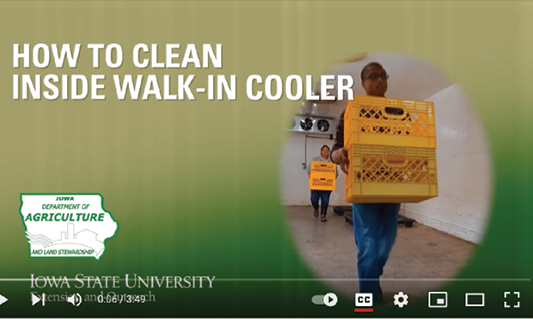

Ethylene
Ethylene is an odorless, colorless gas given off by plant materials and bacteria. It is known as the aging hormone and is detrimental to the life of many types of flowers. Removing sources of ethylene from the cut-flower cooler will lengthen the life of ethylene-sensitive cut flowers. Avoid storing fruit and other food in cut-flower coolers. Keep a separate refrigerator for food.
Ethylene Sources
- Cigarette smoke
- Decaying plant material
- Dying flowers
- Exhaust fumes
- Fading foliage
- Fruit
Botrytis
In this publication’s section about processing cut flowers, we mentioned gray mold (Botrytis cinerea). This mold decreases floral longevity.
Botrytis is in a dormant state just about everywhere, the microscopic, dry spores floating on air and settling on surfaces. Once it meets moisture, it can grow and develop, wreaking havoc on cut flower petals and leaves. Botrytis flourishes in still environments with moist surfaces. This is the same mold that grows on lettuce and other produce in home refrigerators. It makes plant tissues turn mushy and discolored.
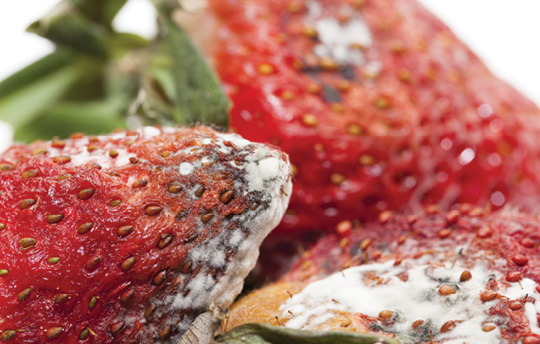
The best way to fight botrytis growth is to eliminate surface moisture in still environments. Remove plastic wraps on flower bunches in the cooler. However, some plastic wraps are necessary to retain freshness, such as corsage bags and plastic boxes. It is fine to design, package, and refrigerate a corsage or boutonniere for a few days, but after a week or two, botrytis will take hold. Be sure to monitor for freshness.
Reduce the spread of botrytis throughout the shop with good sanitation practices. Clean all tools and tabletops using a quaternary ammonium cleaner or a household cleaning solution and rag or sponge. Empty trash cans daily. Wash them with sanitizing solutions and allow them to dry before use.
Get into the good habit of disposing of leaf and stem debris into a trash can or box, not on the workroom floor. Trampled plant material gives off ethylene gas and helps to distribute botrytis spores throughout the space. Plant material debris also is a fall hazard and makes the shop look messy.
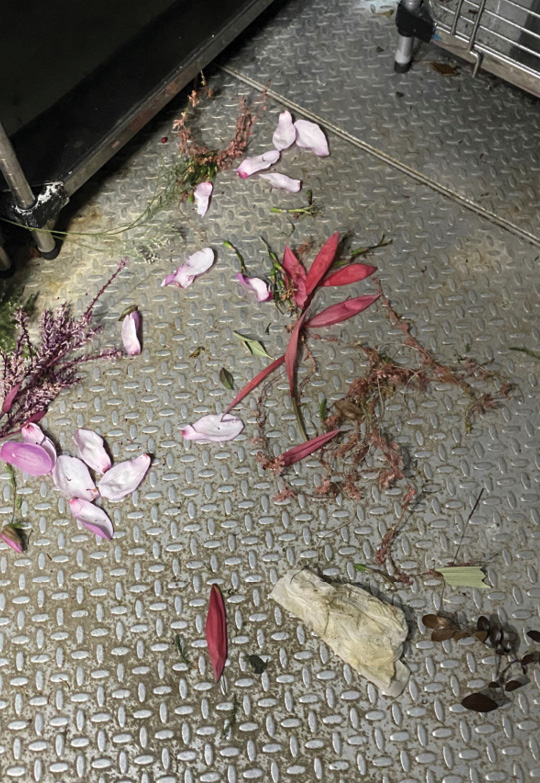
Tropisms
Plant materials naturally bend (tropism) according to two forces: light and gravity. This ability helps them to orient their roots, shoots, leaves, and flowers to their best advantage. Plant materials that bend toward light sources exhibit phototropism, while those that bend away from gravity are geotropic. These responses are important to recognize because they can have a positive or negative effect on flower aesthetics. A curved stem can be beautiful, but if a curved stem is positioned in a downward direction within a floral design, it may appear wilted to the customer, resulting in a complaint or negative review.
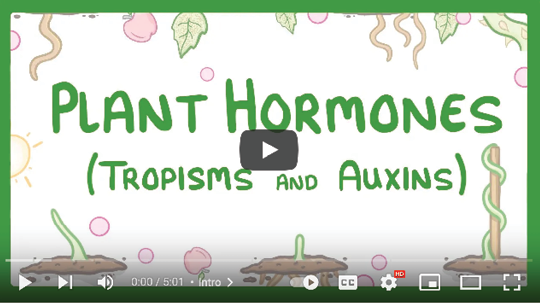
Snapdragons and gladiolus are geotropic. It is best to hold, process, and display them upright to keep the stems relatively straight. Tulips are phototropic flowers. They will bend and turn their flower heads toward strong light sources. Their stems will continue to grow and elongate in floral designs, changing the visual weight and rhythm of an arrangement.
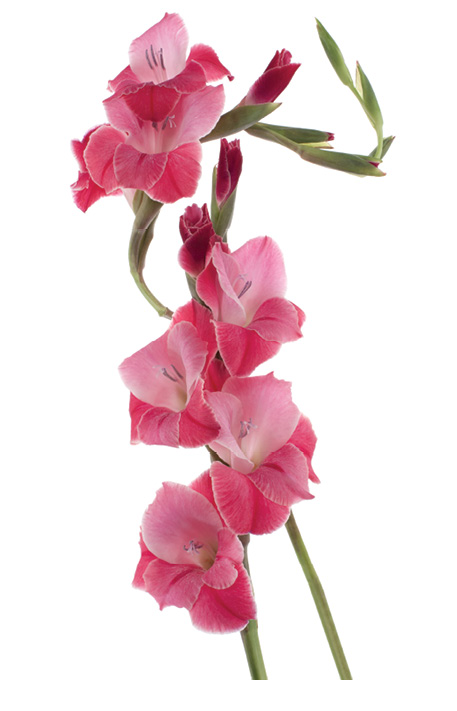
Packaging and Wrapping
Each floral design created by designers in your shop is a work of art. Unlike a sculpture of metal or clay, a floral arrangement is made from living, fresh flowers and is delicate and fragile. Florist delivery staff should carefully wrap and pack each floral design, from a single flower bud vase to a large-scale arrangement for a wedding, so that it arrives in perfect condition. Consider adding a “care tag” that provides instructions to the recipient on keeping the flowers or plants looking their best.

Temperature Extremes
If you follow the instructions in this publication, flowers will last a long time. It is easy to reverse all this good care and handling by ignoring the outdoor weather and temperatures during the delivery phase.
Review the proper storage temperatures for cut flowers. Tropical flowers like orchids and anthurium begin to suffer at temperatures below 40ºF. Temperate zone flowers like roses, lilies, and hydrangeas can be damaged at temperatures below freezing. Take time to warm the delivery vehicle on cold days or cool it down when it is unusually warm outdoors.
Note that thieves can easily steal a van—and its floral contents—while it is running and the keys are in the ignition, so be sure to monitor the vehicle. Keep a spare set or two (or three) of keys in the store, and lock the running vehicle’s doors while it achieves the proper interior temperature.
Safe Handling and Packaging
Take great care when handling flowers and plants. Hold each design under the base of the container. Be sure that the flowers do not bump into the wall or doorframe on the way to the delivery vehicle.
Flowers are a gift of emotion. You are not delivering just flowers—you are helping someone express thoughts that are difficult to put into words!
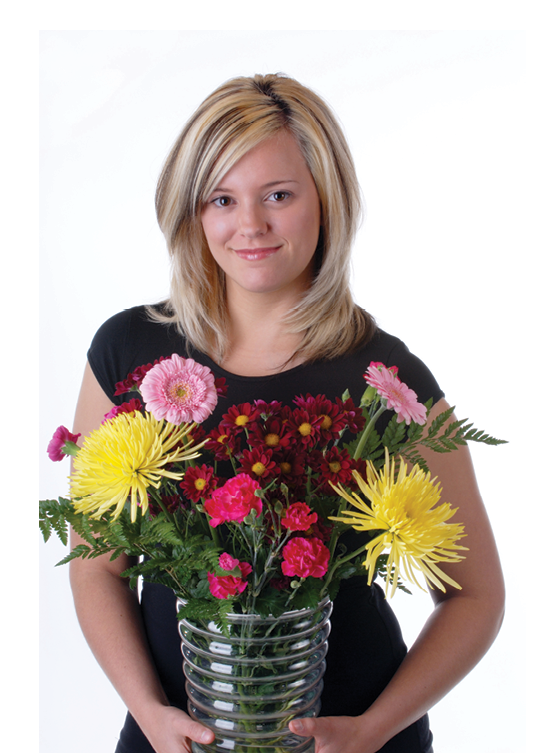
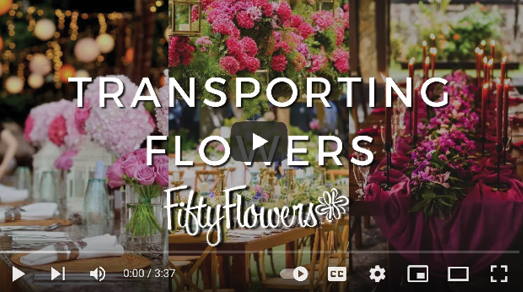
Pack each floral design in a well-fitting box. Many shops use foam carriers with indentations to snugly fit vases and pots. Sandbags are also a popular way to stabilize floral designs during delivery. Of course, accidents happen, but toppled floral designs often damage the flowers or the overall design of arrangements. In this case, the driver must return to the shop for a repair to the arrangement, costing the store time and money.


Delivery Vehicle
The floral delivery vehicle is a satellite unit of the retail floral store or studio. As such, it is a visual manifestation of the goods and services provided by a flower shop. Take care and have pride in your delivery vehicle, both inside and out.
Upkeep and Appearance
The delivery vehicle needs more than gasoline to operate. Have the oil changed as recommended and monitor the tires’ condition. An all-points inspection during oil changes can make the difference in wedding and funeral flowers being delivered on time.
The condition of the delivery vehicle represents your store. Cars and vans should be washed and waxed regularly so that they appear to match the quality of the flower shop’s work. Consider this: Could your shop’s delivery van be used in a wedding or funeral procession? The products and services it provides are used at the most important moments of people’s lives.

The inside of a delivery van should be ready at a moment’s notice to accommodate floral deliveries. First, it should be clean and clear of any plant material debris. Take the time to sweep the floor with a broom or vacuum, then sanitize the ceiling, walls, and flooring, if they are conducive to this type of cleaning. Decaying plant material gives off ethylene gas, which is detrimental to many types of cut flowers.
Courtesy
When on the road, respect other drivers and understand that they know who you are if your company logo is emblazoned on your auto. Turn down the radio when approaching a funeral home. Though it may appear that no services are in process while you are delivering flowers, a bereaved family may be in the office making plans for their loved one’s funeral.
Complete the proper check-ins for hospital and funeral home deliveries. Some hospitals require drivers to make sure that patients receiving flowers are indeed still registered. Many funeral homes have rooms designated for floral delivery, while others rely on florists to place flowers in visitation rooms. It is always a good idea to make sure a hospital or funeral home employee knows you have made a delivery rather than leaving it unattended.

Remember that you are delivering more than just a vase or a plant. As part of your job, you are transporting sensitive information—flowers are code for emotional messages! Every leaf and petal must be perfect. Before you load the delivery van, make sure that the floral designer has not missed any detail such a torn leaf or broken stem. Make sure the card is securely attached to the design.
Mapping
Before leaving the shop, know the delivery route to save time and gasoline expenses. It is wasteful to continually change directions when delivering multiple arrangements around town. Use a city map to develop a delivery route. This expedites delivery to all recipients. Prioritize funeral flowers and deliveries that must reach their destination by a specific time.

Caring for Your Deliveries
You must protect plants and flowers from the effects of weather and temperature extremes. Recall that flowers are stored in refrigeration at temperatures just above freezing. If they are exposed to temperatures below that, even for a few minutes, they can be injured. Proper wrapping and packaging techniques are important to keep flowers safe from the cold. The same is true if temperatures are very warm. Start the vehicle and adjust the thermostat to an appropriate level well before loading the van with delicate flowers and plants.
Carefully pack each design according to management’s directions. It may be the custom to box and wrap each delivery. Some shops use sandbags to anchor containers in place in the van. Others use rigid foam holders or a combination of techniques. Ultimately, it is your responsibility to make sure each arrangement appears the same in the recipient’s hands as it did when it left the design bench.
Be sure to lock the van while loading and unloading to prevent theft.
Conclusion
Along the chain of life, growers, shippers, and wholesalers work tirelessly to keep cut flowers at their best. Once the flowers arrive at a retail floral shop, it is up the florist to process, store, and design using best handling practices. Rushing or skipping care and handling steps can drastically reduce a cut flower’s life.
Disappointed customers seldom place orders with a floral shop that has not fulfilled their expectations in the past. Customers expect quality flowers. With proper care and handling, most floral designs should last about seven days. By following the procedures explained in this publication, floral designers can ensure that they are doing their part as a link in the chain of life to maintain flower quality.

Resources
Society of American Florists (SAF)
Wholesale Florist & Florist Supplier Association (WF&FSA)
Association of Specialty Cut Flower Growers (ASCFG)
American Institute of Floral Designers (AIFD)
References
McKinley, W., Cravens, L., DelPrince, J. M., Scace, P. D., Gallagher, J., Jaras,P., & McGukin, S. (Eds.). (2022). The AIFD guide to floral design (3rd ed.). Schiffer Publishing.
Dole, J., Stamps, R., Carlson, A., Ahmad, I., & Greer, L. (2017). Postharvest handling of cut flowers and greens (J. Laushman, Ed.). Association of Specialty Cut Flower Growers.
Hunter, N. (2013). The art of floral design (3rd ed.). Delmar.
Johnson, J., McKinley, W., & Benz, B. (2001). Flowers: Creative design. San Jacinto.
Nell, T., & Reid, M. (2000). Flower and plant care: The 21st century approach. Society of American Florists.
Royer, K. (1998). Retailing flowers profitably. Royer.
Scace, P., & DelPrince, J. (2021). Principles of floral design (2nd ed.). Goodheart-Willcox.
University of Minnesota Extension. (2019). Gray mold in the flower garden.
Glossary
Botrytis cinerea (gray mold) – A fungus that infects plant materials leading to soft, brown lesions and tissue collapse. The structures of this fungus are gray and have a downy texture.
chain of life – A sequence of steps and associated techniques to increase vase life. The chain includes growers, transporters, wholesalers, retailers, and consumers.
ethylene – A double-bonded carbon molecule. This naturally occurring plant hormone helps plant materials shift from the flowering phase to the fruiting phase. Aids in fruit ripening and hastens senescence.
flaccid – A cell holding water below its capacity.
geotropism – The growth of plant parts in response to the force of gravity.
gray mold – Botrytis cinerea.
pathogen – A microorganism that can cause disease.
phototropism – The orientation of plant parts in response to light.
quat – A quaternary ammonium compound.
quaternary ammonium compound – A cleaning agent consisting of a positively charged surfactant that readily binds to the negatively charged surfaces of microbes. These cleaners remain effective for long periods even after drying on surfaces.
sanitation – Conditions relating to the good health of plant materials.
senescence – The death of plant tissues.
tropism – The turning of plant parts in response to an external stimulus.
turgid – A puffy cell that is at its water-holding capacity.
vase life – The amount of time flowers remain beautiful and useable.
wilt – Tissues with flaccid cells.
Special thanks to Dr. Christian Stephenson for the knife-sharpening video demonstration.
The information given here is for educational purposes only. References to commercial products, trade names, or suppliers are made with the understanding that no endorsement is implied and that no discrimination against other products or suppliers is intended.
Publication 3853 (POD-06-23)
By James M. DelPrince, PhD, AIFD, PFCI, AAF, Associate Extension Professor, Coastal Mississippi Research and Extension Center; Cole Etheredge, PhD, CFD, Assistant Professor, Plant and Soil Sciences; and Lynette McDougald, AIFD, Instructor, Plant and Soil Sciences.
The Mississippi State University Extension Service is working to ensure all web content is accessible to all users. If you need assistance accessing any of our content, please email the webteam or call 662-325-2262.

